DIGS O' THE DAY (2009-04-19): AN AFTERNOON IN THE MAYOR'S YARD
 lordmarcovan
Posts: 44,027 ✭✭✭✭✭
lordmarcovan
Posts: 44,027 ✭✭✭✭✭
DIGS O' THE DAY (2009-04-19): AN AFTERNOON IN THE MAYOR'S YARD
This outing was fated to be my lone detector story for 2009, and it didn't get written up until now (mid-March, 2010). The pictures were taken on the day of the dig, however. I went on maybe two other short outings last year, but they were fruitless and I went dormant for about ten months. Aside from a couple of semi-successful fossil hunting outings which also never got written about, 2009 was a very slack year for me on the treasure hunting front. I am gradually shaking off the lethargy and hope to “put the coil to the soil” more often in 2010.
April 19, 2009 was a fine spring day and I decided to go detecting. I really wasn't sure where I would go, as I didn't have any permissions lined up for new sites, so I decided to revisit my old hunting grounds- the squares and sidewalk strips of Old Town Brunswick, Georgia. I think I stopped by my friend Ty's house to see if he wanted to accompany me, but he wasn't home. From there, I went a few blocks north until I came to Halifax Square. The blocks surrounding Halifax Square have been very good to me in the past. It is a nice neighborhood of stately Victorian homes, and the yards, sidewalks, and median strips are productive detecting sites.
On one side of the square is a house owned by the former mayor of Brunswick. Though we move in different social circles, I know him, since we both graduated from the same high school class. (Glynn Academy, Eighty-Four! We're the best, there ain't no more!) He happens to be a collector of military relics and has shown interest in some of the old buttons and buckles we've dug in the past, but not so much in the process of relic hunting itself. To me, the thrill of finding historical relics is the most exciting thing about them.
Today, as I rolled up the street, I noticed he was standing in his yard. At first I thought he was raking leaves, but then I realized there were no leaves on his lawn, or grass, either. Apparently he was having new sod put in. The yard was nothing but naked grey dirt, and y'all should know by now how much I love naked dirt! Naked dirt surrounding an old Victorian house is all the more appealing. Victorian yards are some of my favorite places to detect, because they are usually full of old coins and other goodies, and, being private property, they often have never been touched by a detector's searchcoil. They're like little private time capsules waiting for some lucky detectorist to come and open them.
Years before, I'd found a high grade 1894-O Barber quarter in the Prince Street traffic median just south of this house, and Indian Head cents and other goodies in the public sidewalk strip adjacent to it, so I had always wanted to try this yard out. I'd never had the nerve to ask our good mayor if I could cut plugs or dig holes in his manicured lawn, however. Now was the perfect opportunity, since there was no grass to be concerned about. If I could get permission, I’d have a limited window of opportunity to hunt this potentially great old yard as a "naked dirt" site. Naked dirt makes the actual digging easier, and sometimes when it's been churned up, the older items are closer to the surface.
I asked and received permission. Yes! It's always a big rush when I get the green light to hunt what might be virgin territory. I wasted no time, and got my gear out. Starting alongside the walk that led up to the front door, I began popping pennies right and left, but they were all modern. Eventually one with wheat ears on the reverse turned up. It was a common Wheat cent from the 1940s, if I remember correctly. I was finding plenty of change but most of it was relatively new. Still, I knew there had to be some silver in this yard.
If we assume the house had been built in 1890 (I forget the exact date it was built, now, but it was close to that), then for the first 19 years it stood, any penny dropped in the yard would have been an Indian Head cent. And any dime, quarter, or larger-denomination coin lost in its first 74 years would have been silver. Those are some pretty good odds. A detectorist who wants to find older coins needs to think this way, and go to the places where older coins were carried and spent, obviously. This place oozed potential. Still, after a short while I had only the one Wheat penny and nothing but modern change.
The ex-mayor's young son followed me around for a little while, and I gave him all of the modern coins I dug. We got him a pretty good pile of them going on the front stoop.
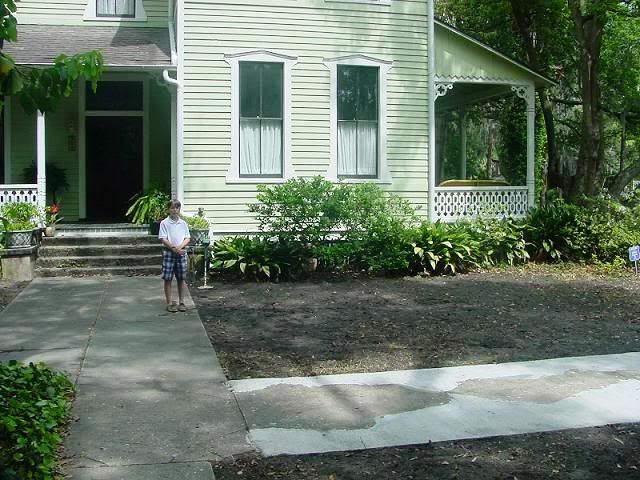
The next find was more of the era I'd hoped for, and it was metallic and round, but not a coin. It was the brass lid off some kind of container- a lady's compact, I’d thought at first. Then I noticed it was covered with an inscription. It had once been the lid on a container of fasteners, and it bore patent dates of 1875 and 1883. I initially thought these “fasteners” might have been nails or screws of some kind, but further research indicated they were paper fasteners of some sort, apparently the forerunners of our modern staples. (The word “stapler” first appeared on a patent in the late 1880s.) These early staples were probably brass and would have looked quite different from what we think of as a staple these days.
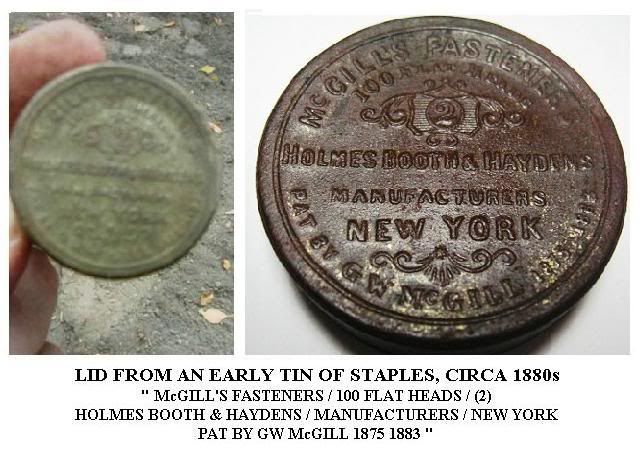
I found a few more common Wheat cents, the oldest being from about 1935, as I recall. Near one of the sidewalks, I dug a collar bar decoration from a military uniform. It was plain, without any ornamentation, but traces of its original gilt plating remained.
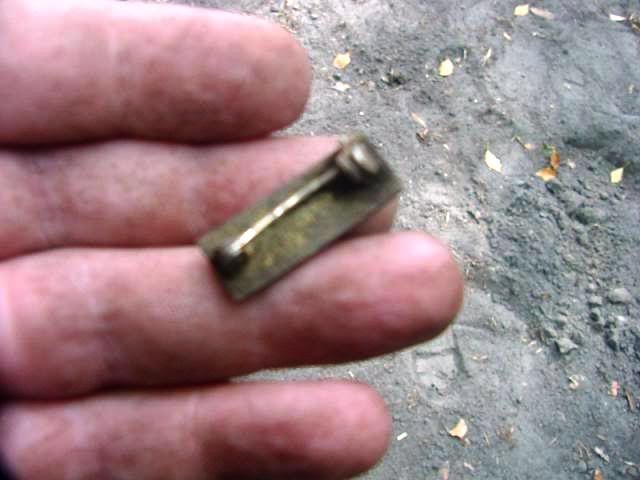
I dug more modern change, but none of the silver coins I’d expected to see. Finally, something silver showed up in the grey soil. My heart skipped a beat.
I saw what initially appeared to be a very old coin with a crowned, scaly creature on it, perhaps a dragon. It bore an abbreviated Latin inscription: “FRANCISC D.G. FRANCOR REX”.
I recognized the inscription right away, having once owned a French gold ecu coin of Francis the First (1515-1547), with similar abbreviations. The inscription roughly translates to: “Francis, by the grace of God, King of France”. I also vaguely remembered that Francis I had a salamander as his symbol, so the scaly creature wasn’t a dragon after all. Not to be confused with the actual amphibious creature, the salamander of myth and legend lived in fire and was rather dragonlike. I believe it symbolized the triumph of faith.
Wow. My heart skipped another beat, when I considered the implications of finding a silver artifact with the crest of a sixteenth century French king on it!
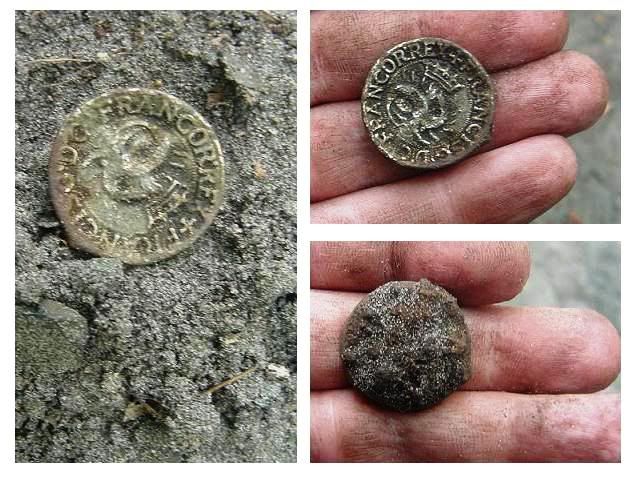
It had rusty encrustations on one side, which proved to be the remains of an old steel backing, so I discovered soon enough that it was a button, not a coin. Furthermore, it could not possibly date to the time of Francis I in the early sixteenth century, as two-piece buttons with steel backs like that didn’t come along until around the middle of the nineteenth century. So it was fairly obvious that this was a Victorian button. Even if it hadn’t been in the ground for five centuries, it was a century old, at least, and silver, so that made it a good find, regardless.
The mystery of why a Victorian button would bear the crest of a Renaissance king still remains unsolved, at least to me.
My buddy Ty, who I’d looked for earlier, came up the street, walking his dog. I showed him the button, and took a short break while he borrowed my detector and took it for a spin around the yard. I don’t remember, but I think he might have found a Wheat cent and a little bit of modern change. We talked to the former mayor a while, and during this sidewalk conversation, the current mayor walked by. Two mayors in the same neighborhood- how ‘bout that? We’re a relatively small city, but not that small.
After Ty had had a little fun and handed the detector back to me, I resumed my search and dug another penny from a moderate depth. As I recall, its signal showed up on the machine’s meter a bit below the usual “penny” range. This is often the indication of a post-1982 modern cent, as those are almost solid zinc with only a thin copper plating. Zinc cents are a drag, because they almost aren't worth the effort of digging them up. Sometimes such a signal can also mean an Indian Head cent from 1909 or earlier, however.
Happily, the latter scenario applied with this particular signal. It proved to be a 1905 Indian cent.
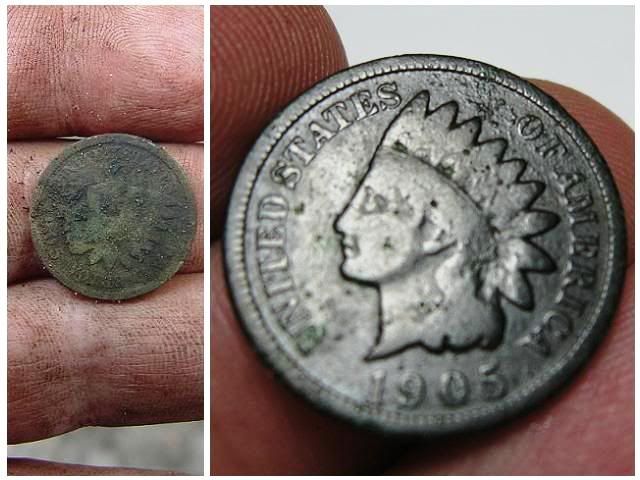
I never found the silver coin I’d hoped and half expected to dig there, but the Indian cent, the silver Francis button, and the old brass lid were interesting enough for me to chalk up the day as a success.
~RWS
INDEX OF DIG STORIES
This outing was fated to be my lone detector story for 2009, and it didn't get written up until now (mid-March, 2010). The pictures were taken on the day of the dig, however. I went on maybe two other short outings last year, but they were fruitless and I went dormant for about ten months. Aside from a couple of semi-successful fossil hunting outings which also never got written about, 2009 was a very slack year for me on the treasure hunting front. I am gradually shaking off the lethargy and hope to “put the coil to the soil” more often in 2010.
April 19, 2009 was a fine spring day and I decided to go detecting. I really wasn't sure where I would go, as I didn't have any permissions lined up for new sites, so I decided to revisit my old hunting grounds- the squares and sidewalk strips of Old Town Brunswick, Georgia. I think I stopped by my friend Ty's house to see if he wanted to accompany me, but he wasn't home. From there, I went a few blocks north until I came to Halifax Square. The blocks surrounding Halifax Square have been very good to me in the past. It is a nice neighborhood of stately Victorian homes, and the yards, sidewalks, and median strips are productive detecting sites.
On one side of the square is a house owned by the former mayor of Brunswick. Though we move in different social circles, I know him, since we both graduated from the same high school class. (Glynn Academy, Eighty-Four! We're the best, there ain't no more!) He happens to be a collector of military relics and has shown interest in some of the old buttons and buckles we've dug in the past, but not so much in the process of relic hunting itself. To me, the thrill of finding historical relics is the most exciting thing about them.
Today, as I rolled up the street, I noticed he was standing in his yard. At first I thought he was raking leaves, but then I realized there were no leaves on his lawn, or grass, either. Apparently he was having new sod put in. The yard was nothing but naked grey dirt, and y'all should know by now how much I love naked dirt! Naked dirt surrounding an old Victorian house is all the more appealing. Victorian yards are some of my favorite places to detect, because they are usually full of old coins and other goodies, and, being private property, they often have never been touched by a detector's searchcoil. They're like little private time capsules waiting for some lucky detectorist to come and open them.
Years before, I'd found a high grade 1894-O Barber quarter in the Prince Street traffic median just south of this house, and Indian Head cents and other goodies in the public sidewalk strip adjacent to it, so I had always wanted to try this yard out. I'd never had the nerve to ask our good mayor if I could cut plugs or dig holes in his manicured lawn, however. Now was the perfect opportunity, since there was no grass to be concerned about. If I could get permission, I’d have a limited window of opportunity to hunt this potentially great old yard as a "naked dirt" site. Naked dirt makes the actual digging easier, and sometimes when it's been churned up, the older items are closer to the surface.
I asked and received permission. Yes! It's always a big rush when I get the green light to hunt what might be virgin territory. I wasted no time, and got my gear out. Starting alongside the walk that led up to the front door, I began popping pennies right and left, but they were all modern. Eventually one with wheat ears on the reverse turned up. It was a common Wheat cent from the 1940s, if I remember correctly. I was finding plenty of change but most of it was relatively new. Still, I knew there had to be some silver in this yard.
If we assume the house had been built in 1890 (I forget the exact date it was built, now, but it was close to that), then for the first 19 years it stood, any penny dropped in the yard would have been an Indian Head cent. And any dime, quarter, or larger-denomination coin lost in its first 74 years would have been silver. Those are some pretty good odds. A detectorist who wants to find older coins needs to think this way, and go to the places where older coins were carried and spent, obviously. This place oozed potential. Still, after a short while I had only the one Wheat penny and nothing but modern change.
The ex-mayor's young son followed me around for a little while, and I gave him all of the modern coins I dug. We got him a pretty good pile of them going on the front stoop.

The next find was more of the era I'd hoped for, and it was metallic and round, but not a coin. It was the brass lid off some kind of container- a lady's compact, I’d thought at first. Then I noticed it was covered with an inscription. It had once been the lid on a container of fasteners, and it bore patent dates of 1875 and 1883. I initially thought these “fasteners” might have been nails or screws of some kind, but further research indicated they were paper fasteners of some sort, apparently the forerunners of our modern staples. (The word “stapler” first appeared on a patent in the late 1880s.) These early staples were probably brass and would have looked quite different from what we think of as a staple these days.

I found a few more common Wheat cents, the oldest being from about 1935, as I recall. Near one of the sidewalks, I dug a collar bar decoration from a military uniform. It was plain, without any ornamentation, but traces of its original gilt plating remained.

I dug more modern change, but none of the silver coins I’d expected to see. Finally, something silver showed up in the grey soil. My heart skipped a beat.
I saw what initially appeared to be a very old coin with a crowned, scaly creature on it, perhaps a dragon. It bore an abbreviated Latin inscription: “FRANCISC D.G. FRANCOR REX”.
I recognized the inscription right away, having once owned a French gold ecu coin of Francis the First (1515-1547), with similar abbreviations. The inscription roughly translates to: “Francis, by the grace of God, King of France”. I also vaguely remembered that Francis I had a salamander as his symbol, so the scaly creature wasn’t a dragon after all. Not to be confused with the actual amphibious creature, the salamander of myth and legend lived in fire and was rather dragonlike. I believe it symbolized the triumph of faith.
Wow. My heart skipped another beat, when I considered the implications of finding a silver artifact with the crest of a sixteenth century French king on it!

It had rusty encrustations on one side, which proved to be the remains of an old steel backing, so I discovered soon enough that it was a button, not a coin. Furthermore, it could not possibly date to the time of Francis I in the early sixteenth century, as two-piece buttons with steel backs like that didn’t come along until around the middle of the nineteenth century. So it was fairly obvious that this was a Victorian button. Even if it hadn’t been in the ground for five centuries, it was a century old, at least, and silver, so that made it a good find, regardless.
The mystery of why a Victorian button would bear the crest of a Renaissance king still remains unsolved, at least to me.
My buddy Ty, who I’d looked for earlier, came up the street, walking his dog. I showed him the button, and took a short break while he borrowed my detector and took it for a spin around the yard. I don’t remember, but I think he might have found a Wheat cent and a little bit of modern change. We talked to the former mayor a while, and during this sidewalk conversation, the current mayor walked by. Two mayors in the same neighborhood- how ‘bout that? We’re a relatively small city, but not that small.
After Ty had had a little fun and handed the detector back to me, I resumed my search and dug another penny from a moderate depth. As I recall, its signal showed up on the machine’s meter a bit below the usual “penny” range. This is often the indication of a post-1982 modern cent, as those are almost solid zinc with only a thin copper plating. Zinc cents are a drag, because they almost aren't worth the effort of digging them up. Sometimes such a signal can also mean an Indian Head cent from 1909 or earlier, however.
Happily, the latter scenario applied with this particular signal. It proved to be a 1905 Indian cent.

I never found the silver coin I’d hoped and half expected to dig there, but the Indian cent, the silver Francis button, and the old brass lid were interesting enough for me to chalk up the day as a success.
~RWS
INDEX OF DIG STORIES
Collector since 1976. On the CU forums here since 2001.
0
Comments
Tomorrow I plan to work on the most recent outing I made on Sunday (2010-03-14): "BACK TO BLACK BANKS". I took lots of pictures and those are now cropped and ready, but I still need to do the actual writeup.
I also should be able to pick up the CD from Network Monkeys tomorrow. They're the computer repair place that retrieved the data from the hard drive of my deceased laptop (which was pronounced DOA when I brought it in). That means I should once again have access to the original pictures for a lot of the old stories which had the pictures go bad when my image host went bye-bye. I can re-upload the pics to Photobucket and resurrect some of the 2007-2008 stories that have red-X pictures.
From there, I've still got unwritten stories and fragments from the past five years that have to be excavated from various places in cyberspace, and stitched together into something semi-coherent.
Collector since 1976. On the CU forums here since 2001.
Most of my better finds happened in my pre-Internet, pre-photography days, though, so they never got written about. I was more active in the 1990s than I am today. It just dawned on me yesterday that I haven't found a single pre-1900 coin since I started all this writing and photographing. Maybe I jinxed myself.
Edit- no, wait, that isn't true. I dug an 1889 V-nickel in the story called "The Curious, Crusty Concretion".
Can't recall digging any 18th or 19th century silver since I started writing, though. I think the last was a Spanish 1-real piece (date worn off, but circa 1770s) that I dug in SC in 2003.
Collector since 1976. On the CU forums here since 2001.
Curious... how do you go about asking permission? Like, do you just walk up and blurt out the question, or do you make (awkward) small talk before asking? I'd like to try some houses, but was always unsure how to start the conversation. If you got permission at the mayor's house, you must have the permission-asking skills down!
The fact is, permission-gaining is difficult for me, as I am more of an introverted, semi-shy type in person (not that you'd believe it from seeing my online persona).
My work background is in Hospitality (i.e., customer service) so I am at least able to communicate politely with people. It's still awkward, coming cold out of left field with what to most people will seem like a bizarre request. I sometimes joke about this, saying something along the lines of "Hey, I have a bizarre request."
The mayor was easy to approach- I knew him previously, and we'd graduated high school together, even if we weren't buddies or anything. He had been mildly interested in what I was doing in the past, since he is a collector of military relics.
Not everyone is so easy. Here in the South, folks tend to be friendly, but that is not always the case, particularly if you are a stranger knocking on the door. That is tough.
I've tried to develop strategies, like the "pay for play" scheme. Putting myself in the homeowner's shoes, I wonder how I would react if some weirdo came up to the door with a question like that? He wants to dig holes in my lawn? Huh. What's in it for me? This is why I've decided to start offering a little money, or a low-grade, larger silver coin like a Walker half or a cheap silver dollar as an incentive for the homeowners of yards I really want to hunt (not coins I've dug, since I keep those). Figure ten or twenty bucks' value. It's a gamble, since I don't know what I will find, and I seldom find ten or twenty dollars worth of stuff, but the point is, the homeowner has to be offered something, somehow, so I am not depending purely on a stranger's generosity.
A lot of property owners are generous, though, and say, "enjoy yourself", and waive any fees offered.
(Then there's the flipside, where the homeowners see what you've found, get excited, and politely exclude you from coming back since they want to get a detector and try it out themselves- that has happened to me two or three times, but hey- it's their property.)
Overall, I would say I am NOT that great at asking permission, which is why I've hunted so many of the same public parks and sidewalk strips over and over and over again, ad nauseam, with ever diminishing results. You can never truly "clean out" a good site, but it is a fact that the goodies get smaller and deeper and ever more difficult to find with every time a site's been hunted.
In the past, my buddy Ty has been great to have along since he knows dozens of people in Old Town and is a perfect ambassador who is unafraid to ask permission.
Collector since 1976. On the CU forums here since 2001.